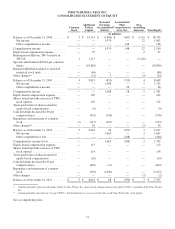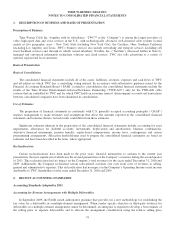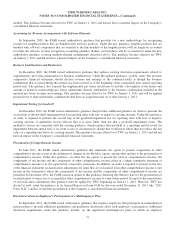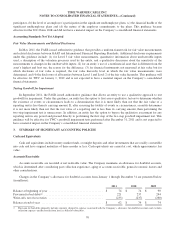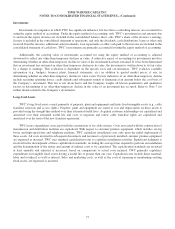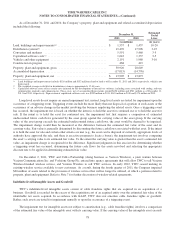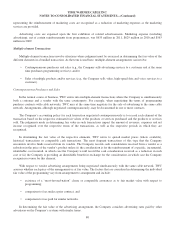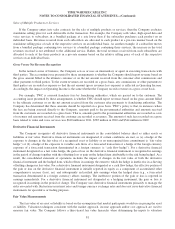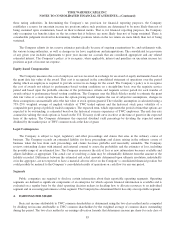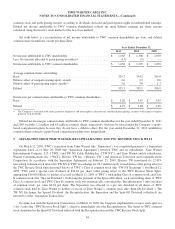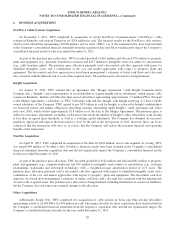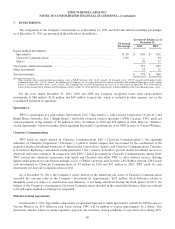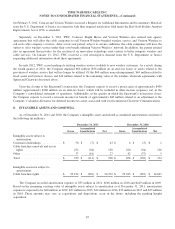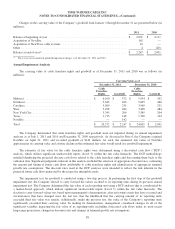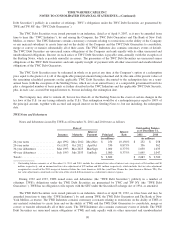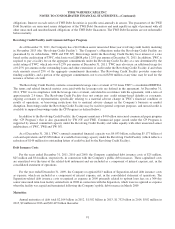Time Warner Cable 2011 Annual Report Download - page 90
Download and view the complete annual report
Please find page 90 of the 2011 Time Warner Cable annual report below. You can navigate through the pages in the report by either clicking on the pages listed below, or by using the keyword search tool below to find specific information within the annual report.TIME WARNER CABLE INC.
NOTES TO CONSOLIDATED FINANCIAL STATEMENTS—(Continued)
techniques. The fair value hierarchy prioritizes the inputs to valuation techniques into three broad levels in order to maximize
the use of observable inputs and minimize the use of unobservable inputs. The levels of the fair value hierarchy are as
follows:
• Level 1: consists of financial instruments whose values are based on quoted market prices for identical financial
instruments in an active market.
• Level 2: consists of financial instruments whose values are determined using models or other valuation
methodologies that utilize inputs that are observable either directly or indirectly, including (i) quoted prices for
similar assets or liabilities in active markets, (ii) quoted prices for identical or similar assets or liabilities in markets
that are not active, (iii) pricing models whose inputs are observable for substantially the full term of the financial
instrument and (iv) pricing models whose inputs are derived principally from or corroborated by observable market
data through correlation or other means for substantially the full term of the financial instrument.
• Level 3: consists of financial instruments whose values are determined using pricing models that utilize significant
inputs that are primarily unobservable, discounted cash flow methodologies, or similar techniques, as well as
instruments for which the determination of fair value requires significant management judgment or estimation.
Accounting for Pension Plans
TWC sponsors qualified noncontributory defined benefit pension plans covering a majority of its employees. TWC also
provides a nonqualified noncontributory defined benefit pension plan for certain employees. Pension benefits are based on
formulas that reflect the employees’ years of service and compensation during their employment period. The pension
expense recognized by the Company is determined using certain assumptions, including the expected long-term rate of return
on plan assets, the interest factor implied by the discount rate and the expected rate of compensation increases.
Income Taxes
Prior to the Separation (as defined in Note 5), TWC was not a separate taxable entity for U.S. federal and various state
income tax purposes and its results were included in the consolidated U.S. federal and certain state income tax returns of
Time Warner Inc. (“Time Warner”). The income tax benefits and provisions, related tax payments, and current and deferred
tax balances have been prepared as if TWC operated as a stand-alone taxpayer for all periods presented including periods
through the date of the Separation. Under the tax sharing arrangement between TWC and Time Warner, TWC is obligated to
make tax sharing payments to Time Warner in amounts equal to the estimated taxes it would have paid if it were a separate
taxpayer and Time Warner is obligated to make payments to TWC for TWC tax attributes used by Time Warner, but only as
and when TWC as a standalone taxpayer would have been able to use such attributes itself. The Company received net cash
tax refunds from Time Warner of $87 million in 2010 and $44 million in 2009.
Income taxes are provided using the asset and liability method.Under this method, income taxes (i.e., deferred tax
assets, deferred tax liabilities, taxes currently payable/refunds receivable and tax expense) are recorded based on amounts
refundable or payable in the current year and include the results of any difference between GAAP and tax reporting. Deferred
income taxes reflect the tax effect of net operating losses, capital losses, general business credit carryforwards and the net tax
effects of temporary differences between the carrying amount of assets and liabilities for financial statement and income tax
purposes, based upon enacted tax laws and expected tax rates that will be in effect when the temporary differences reverse.
Valuation allowances are established when management determines that it is more likely than not that some portion or the
entire deferred tax asset will not be realized. The financial effect of changes in tax laws or rates is accounted for in the period
of enactment.
From time to time, the Company engages in transactions in which the tax consequences may be subject to uncertainty.
Examples of such transactions include business acquisitions and dispositions, including dispositions designed to be tax free,
issues related to consideration paid or received, investments and certain financing transactions. Significant judgment is
required in assessing and estimating the tax consequences of these transactions. The Company prepares and files tax returns
based on interpretation of tax laws and regulations. In the normal course of business, the Company’s tax returns are subject
to examination by various taxing authorities. Such examinations may result in future tax, interest and penalty assessments by
82



